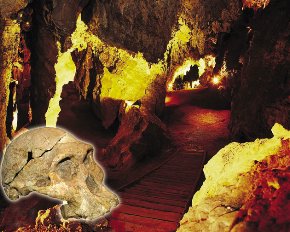
See The Cradle Of Humankind - Natural Attraction

It offers a boat ride on an underground lake, exploring the different forms of water. From there, the visitor walks down an underground spine, exploring through interactive displays the discovery of fire, extinction and DNA, among other things. With her mix of ape and hominid features, Mrs Ples dates back some 2.5 million years, and to date remains the most complete and best preserved specimen of the genus Australopithecus africanus. These discoveries are of great significance in our search for the origins of humankind, and give credence to the designation, Cradle of Humankind.
Apart from Mrs Ples, the discoveries in the Cradle of Humankind include the complete skeleton of Little Foot, a 3.3 million year old ape-man specimen, more than 900 hominid fossils, over 500 fragments of fossil wood, and over 9,100 stone tools, dating back some two million years. The range of other creatures which co-existed in the area include extinct animals such as short-necked giraffe, giant buffalo, giant hyena and several species of saber-toothed cats. Numerous fossils of extant creatures such as leopards and hartebeest have also been found.The site comprises of a strip of a dozen dolomitic limestone caves and covers 47 000 hectares of privately owned land containing the fossilized remains of ancient forms of animals, plants and hominids. The dolomite in which the caves are formed, started out as coral reefs growing in a worm shallow sea about 2.3 billion years ago.
As the reefs died off they were transformed into limestone which some time later was converted into dolomite. Millions of years later after the sea had receded; slightly acidic groundwater began to dissolve out calcium carbonate from the dolomite to form underground caverns. The water table began to drop and the underground caverns were exposed to the fresh air. The percolation of acidic water through the dolomite also dissolved calcium carbonates out of the rock into the caverns, which formed stalactites, stalagmites and other crystalline structures. The continued erosion on the earth's surface and dissolution of the dolomite eventually resulted in shafts or taverns forming between the surface of the earth and the caverns below. Bones, stones and plants washed down these shafts into the caves; and animals and hominids fell into the caves, became trapped and died there. The bones and plant remains became fossilized and along with various stones and pebbles became cemented in a hard mixture called breccias.
At least eight of the twelve sites have yielded hominid remains. In fact, together these caves have produced over 900 hominid fossil remains, so that to date they represent one of the world's richest concentrations of fossil hominid bearing sites. The scientific value of this area lies in the fact that these sites provide us with a window into the past, to a time when our earliest ancestors were evolving and changing. Most scientists have accepted the human origins in began in Africa. This world Heritage site is a must see attraction when in Johannesburg.


